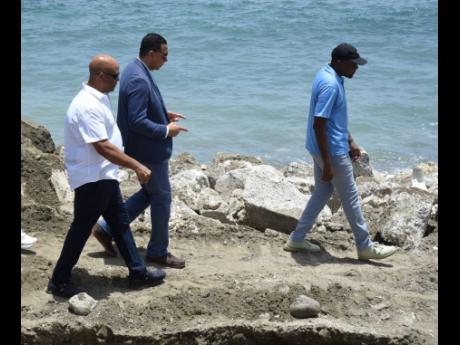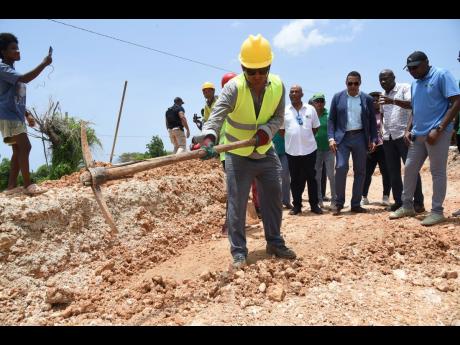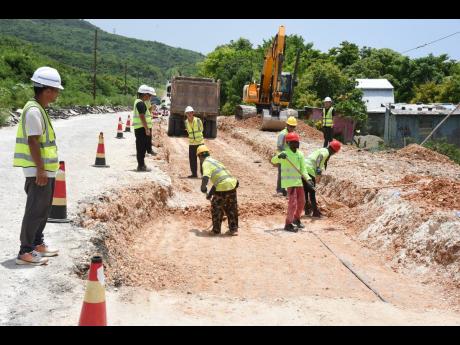Holness: Moving coastal roads inland the real solution to sea damage
PM inspects failures along Southern Coastal Highway Improvement Project in St Thomas
Prime Minister Andrew Holness has expressed disappointment over the damage caused to sections of roadway under the Southern Coastal Highway Improvement Project (SCHIP) in St Thomas, as a result of the use of poor-quality materials and exacerbated by last month’s passage of Hurricane Beryl.
Nevertheless, Holness said yesterday he wished to reassure Jamaicans that systems are in place to safeguard the infrastructural investment.
The prime minister, who was touring the sections along the Southern Coastal Highway that are in need of repair, was accompanied by representatives of contractors China Harbour Engineering Company (CHEC) and the National Works Agency (NWA).
Holness argued that, while he was disappointed that sections of the road have failed, he felt it important to note that the failures have occurred within the contract period during which “the contractor, CHEC, has an obligation to deliver the road to a particular standard”.
As a result of this liability period, there will be no additional cost to the government to cover the damage along the roadway.
Holness’ comments reiterated a statement on the weekend by CHEC in which it took responsibility for quality control of the road work carried out, including by its local subcontractors, on the highway.
Under the agreement between the government and CHEC, there is a defect liability period of two years which protects the infrastructure, making the contractor liable for any failure or damage that occurs after the road is handed over.
Single-lane usage
The affected sections of the roughly 1.6 kilometre-stretch include the Salt Pond, Yallahs to Pamphret leg, part of which has been reduced to single-lane usage; a breakaway of the seawall along the Roselle main road, as well as a section of Arcadia.
Speaking with journalists at the Pamphret site, Kristoffer Henry, civil engineer at CHEC, shared that, during a previous routine inspection, defects were noticed and presented as cracks. However, after the category-four hurricane passed over the island, the cracks “opened up” and resulted in further damage.
Henry continued that instructions have been given to CHEC’s construction team to repair these issues and that work has started.
“The issue was, we were on a rigorous timeline in tranche three, that’s the leg from Morant Bay to Portland, so the construction team, especially the earth work team, they weren’t able to be diverted to this location [but] we’re here now and we’re committed to this Pamphret section, Seaforth and small areas in Cedar Valley,” Henry said.
In its statement on the weekend, CHEC indicated that the damage would be repaired within three weeks.
Holness stated that the SCHIP is a “massive” and “complicated” project, and noted that, for the Pamphret leg of the roadway, although the section of the quarry was certified and random routine sampling was done to test the material, there remained a residual risk that materials would not be up to standard.
He continued that it was a road test that had revealed some material failure, and that the quality of material had been affected by contamination.
Holness reasoned that, “from day one we know that this is not the best alignment because even the road that was here before suffered the same fate”. He added that “the water table is very high in proximity to the sea and a swamp” and that undoubtedly there would be issues with the roadway.
The prime minister, however, commended the quality control system in place that was able to pick up these failures and correct them. He further reasoned that, from a climate change perspective, it was necessary to move the roads inland.
For the 68-kilometres Roselle leg, Dionne Sampson-Russell, technical manager from SJE Consultants, which represents the government’s interest in the project, explained to journalists that this segment of the roadway had no prior issues and was completed before the passage of the hurricane.
“But, because there was no protection from high tides and continuous sea impact, it failed during that storm event. However, [through] the commitment of the team and China Harbour, we are repairing and fully replacing this section of roadway,” she said.
Sampson-Russell revealed that, to remedy the situation, a new five-metre deep, rubble masonry wall would be constructed with at least one and a half metres of the wall below ground, to ensure a good foundation.
“At this point, the contractors have already started to layer the debris, remove the sections of the collapsed wall, and have started excavating,” she said.
Holness noted that this aspect of repairs was classified as supplementary work where an additional budget was needed to put in a seawall.
He continued that the erection of the seawall was not the final or most effective defence for the area and noted that other revetment works were needed but were very expensive and could cost two to three times more than the actual roadway.
“The real solution to this problem is to realign the road, to move the road from the coast,” he said, adding that a decision has been taken by the Government to move the nation’s roads – as much as possible – inland and change the alignments away from the sea or waterways.
This, Holness stated, would be done over the long-term where another road would be built more inland and the purpose of that is to create new communities along those roads.
“We have actually started with the development and the identification [and] acquisition of lands for the Port Antonio bypass ... and then, over time, connect that bypass with a road that is more inland that will lead us now to be connected to the section of Harbour View to Yallahs,” he said.



